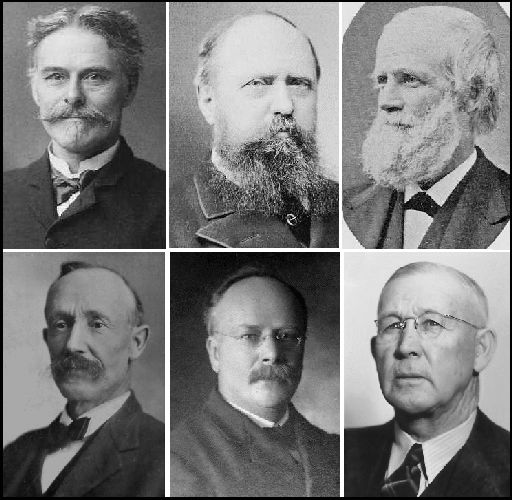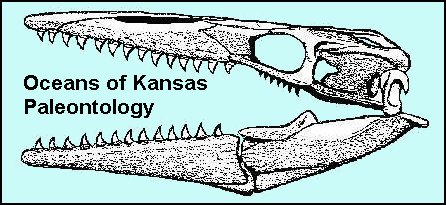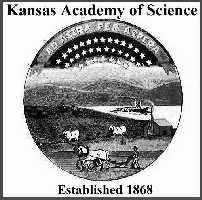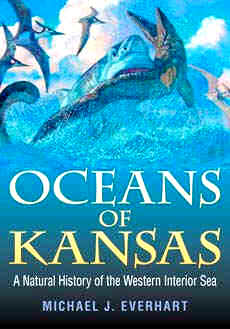|
Bader,
K.S1 and Martin, L.D.2, 1.
Petrified Forest
National Park
and, 2. University of
Kansas
Natural
History
Museum
and
Biodiversity
Research
Center
. Snake
Coprolites from the Pleistocene Angus Local Fauna,
Nebraska
. Coprolites from a Pleistocene fluvial deposit preserve
characteristics that aid in the identification of a tracemaker. They were
collected while screen washing sediment from the Angus Local Fauna (UNSM
Coll. Loc. No-101), a Lower Illinoian deposit located one and one-half
miles southwest of
Angus
,
Nebraska
. The deposit is interpreted as a small oxbow pond formed from a tributary
of a larger stream and contains a diverse fauna of fish, amphibians,
reptiles, birds and mammals. It is overlain by windblown silts of the
Loveland Loess Formation containing two buried soil horizons, the Sangamon
Paleosoil and the Peoria Loess Formation. The coprolites have an
ellipsoidal shape and a unique series of parallel longitudinal grooves on
the surface. Ranid frog bones are exposed on a broken section of one
coprolite. Initial morphological comparison of the coprolite with modern
fecal material excludes all animal taxa except snakes. A survey of solid
fecal material from large (>30 cm adult size) snakes native to the
Great Plains
revealed that only water snakes (Colubridae: Natricinae) produce grooved
feces. Feces from the natricine snake Nerodia
sipedon retained the grooved texture only when deposited out of water
and allowed to dry. Dried N. sipedon
feces that were later submerged overnight did not dissolve or deform nor
were the grooves obscured.
Connolly,
A.M. and Martin, L.D., Department of Geology, University of Kansas, and
Museum of Natural History, University of Kansas.
A PRELIMINARY STUDY ON THE PALEOBIOGEOGRAPHICAL DISTRIBUTION OF
MOSASAURS IN RELATION TO THE SIZE OF THE PARIETAL FORAMEN. Studies on
the biological effects of the parietal foramen (PF) in modern day lizards
and ancient organisms have been minimal at best. There is also a flawed
practice of measuring a PF of a specimen in comparison to its skull area
because species have various and inconsistent skull shapes. The few
studies of the PF however have indicated that the PF helps
thermoregulation in lizards. Lizards that lack a PF in the families of
Agamidae and Iguanidae are found within 10 degrees of the equator while
those that retained a PF are found in higher latitudes. The PF in
Iguanidae species’ skulls were thus measured to test this hypothesis and
found that the higher latitude a species’ habitat is, the larger its PF
is in relation to its occipital condyle. The occipital condyle was used as
a comparison to the PF due to its limitation in variability among species.
Thus, an Iguanidae lizard that is found in a cool, high latitude
environment is dependent upon a large PF to regulate body temperature. An
ongoing study is now comparing this data with the PF size in Mosasaurs
(Order: Squamata, Family: Mosasauridae). The results of this study could
tell what kind of environment the Mosasaur species lived in.
Everhart, M.J., Sternberg
Museum
of
Natural History
,
Fort
Hays
State
University
. CRETACEOUS SHARKS OF
KANSAS
– A REVIEW OF RECENT DISCOVERIES. Cretaceous shark teeth from
Kansas
were first mentioned by John LeConte in his 1868 railroad survey.
Additional specimens were collected by Dr. George M. Sternberg and figured
by Leidy in 1873. E.D. Cope also collected shark teeth during his brief
1871 visit and figured them in his 1875 Cretaceous
Vertebrata. In 1900, Samuel W. Williston described and published
photographs of Cretaceous shark teeth in Volume 6 of the University
Geological Survey of Kansas. During the next one hundred years, however,
little was added to our knowledge of the Cretaceous shark faunas of the
state during the period when much of
Kansas
was covered by the Western Interior Seaway. In the late 1990s, advances
were made in the description of existing specimens, and the compilation
and reporting of species occurring in these Cretaceous deposits. More
recently, a number of previously unreported genera and species of
Cretaceous sharks have been recognized from
Kansas
. These include “paleosharks” (Hybodus
(Meristodonoides) and Polyacrodus),
rays (Rhinobatos and Pseudohypolophus),
sawfishes (Onchopristis and Ptychotrygon),
a bamboo shark (Chiloscyllium),
Carpet sharks (Cantioscyllium and Orectoloboides), Lamniform sharks
including a Megamouth shark (Megachasma)
and Cardabiodon, Cretodus,
Carcharias amonensis, Johnlongia
and Archaeolamna, and
several Anacoracid sharks (Pseudocorax,
Squalicorax microserratodon and
other species currently being described). Williston’s (1900) Leptostyrax “bicuspidatus”
is now considered to be a junior synonym of L.
macrorhiza Cope 1875. Additionally, two species of Ptychodus initially named by Williston have also been determined to
be junior synonyms, and reassigned: Ptychodus
anonymus = P. rugosus and P.
polygyrus = P. marginalis.
A.R. Falk1
and Martin, L.D.2, 1. Department of Geology,
University
of
Kansas
and, 2.
Natural
History
Museum
and Biodiversity Institute,
University
of
Kansas
. Comparison
of a Mesozoic Avian Ichnofauna with one from the Early Eocene of
Wyoming
. Comparison of the avian trackway record from the Early Eocene
Green River Formation of Utah with that from the Early Cretaceous of Korea
reveals some interesting similarities. The Korean sample contains some of
the earliest known avian tracks being only twenty or thirty millions of
years younger than Archaeopteryx. The Korean avifauna is composed almost entirely of
water-marginal and aquatic ornithurine birds, as is the Eocene assemblage;
however, the Eocene assemblage contains body fossils, a part of the
record, that the Cretaceous assemblage lacks. The diversity is
approximately the same in the two assemblages
as are the indications of behavioral activity. Several different types
of feeding behaviors are present during both time periods—in the
Cretaceous, probing and pecking behaviors, along with spoonbill-like
scything behaviors, have been reported, and heron-like feeding patterns
have been observed. Dabbling marks alongside webbed-footed tracks from the
Eocene Green River Formation have been reported, and further feeding
behaviors have likely been widely overlooked as they may appear similar to
some invertebrate traces (i.e. Arenicholites). The birds may not have been taxonomically similar,
however, their basic form and behavior suggests that the freshwater
water-margin habitat is one of the earliest ones that was occupied by
ornithurine birds and fully exploited, while the enantiornithines
initially colonized the
terrestrial and arboreal environments. The likelihood that the total
diversity of birds in this realm has not dramatically increased over time
is high, and that study of the modern fauna still has relevance to our
understanding of the ancient ones.
Hageman
,
S.A.
,
Anderson
, C., Katuwal, M. and Hoffman, B.L., Department of Natural and
Physical Sciences,
Park
University
. APPLICATIONS OF GEOGEBRA TO
BIOLOGY AND PALEONTOLOGY. Computer software has become an important
aid in the study of fossils. GeoGebra is an award winning software package
that is user friendly and provides powerful graphical analysis features.
The purpose of this presentation is to demonstrate this freely available
software by providing some examples of how we are using it in some
interdisciplinary collaborations.
Park
University
has been applying GeoGebra to some of its biological and paleontological
collections to record a variety of measurements of specimens and
developing complex animated graphics that can be downloaded to Power Point
presentations. Two recent studies utilizing GeoGebra include an
examination of gastropod borings on clam shells and the classification of
a dinosaur track. The borings were plotted to a relative scale, revealing
a strong accuracy by gastropods for drilling one specific kill shot on the
shell 46% of the time and 79% of the time within a slightly expanded area
of the shell. The dinosaur track was easily measured using a scaled image
to determine key characteristics such as track length, digit length, and
angles between digits. This allowed for comparisons of other dinosaur
tracks to reveal several characteristics strongly suggesting it is an
above average sized hadrosaur footprint. Other studies in the initial
stages involve the data collection from many of the Charles H. Sternberg
Red Deer River dinosaur specimens housed at
Park
University
and an analysis of locally collected trace fossils of Asteriacites.
Hoffman,
B.L., Department of Natural and Physical Sciences,
Park
University
. Epidemiological
Evidence of a Herald Wave of the
1918 Pandemic Influenza Virus in St.
Joseph
,
Missouri
. While the 1918/1919 H1N1 influenza pandemic is widely
recognized as a “worst-case scenario” for the emergence of new
influenza strains, relatively little is known about the origin of the
responsible virus and its pattern of spread. Most studies of this virus in
the
United States
rely on temporally and spatially aggregated data. Location-specific
studies of the impact of the 1918 pandemic strain in the
United States
have been confined primarily to large cities on the East Coast or West
Coast. In this study, data on pneumonia and influenza fatalities from
1910-1923 have been extracted from death certificates for Saint Joseph,
Missouri, a typical mid-sized city in the central United States. An
increase in pneumonia and influenza mortality was noted starting in the
1915/1916 influenza season. Initially, increased mortality was observed in
infants and the elderly. In February 1918, an age-shift typical of
pandemic strains of virus was seen, as the burden of mortality shifted to
young adults, a characteristic of the 1918 pandemic virus. These results
provide one of the first confirmations of the existence of a “herald
wave” of influenza activity in the
United States
prior to the recognized start of the H1N1 pandemic in Spring 1918. This
study is one of very few that measures the impact of 1918/1919 influenza
impact in a particular location in the central
United States
.
Hoffman,
B.L. and
Hageman
,
S.A.
, Department of Natural and Physical Sciences,
Park
University
. SHARK
“TEETH” OF THE FORM GENUS GUNNELLODUS
WILIMOVSKY (IDIACANTHUS GUNNELL)
REPRESENT STETHACANTHID DENTICLES. In 1933, Frank Gunnell assigned the
generic name Idiacanthus to a
set of shark “teeth” with a pointed blade and heavy bony base found in
Pennsylvanian deposits in
Missouri
and
Kansas
. Idiacanthus bellistriatus
carried a single blade with striations and ridges; I.
cameratus had a single blade with striations only and
I.
trispinosus had three striated spines. These ichthyoliths are
common to the marine shales and limestones of the Missourian and Virgilian
series of the Midcontinent region. In 1954, the generic name Gunnellodus
was proposed for these remains, as the generic name Idiacanthus
was preoccupied by an extant group of marine fishes. Literature review
reveals similar remains identified as conodonts with generic names Scolopodus Pander and Multidentodus
Harlton are also found in Mississippian as well as Pennsylvanian marine
deposits. We show by comparative morphology that Gunnellodus-type ichthyoliths share affinities with denticles of
stethacanthid sharks, including Akmonistion
zangerli and Stethacanthus
altonensis. G. bellistriatus,
G. cameratus and Scolopodus are cranial cap and brush denticles, while G.
trispinosus and Multidentodus are buccopharyngeal denticles. Also found with these
ichthyoliths are stethacanthlike cladodont teeth and tooth whorls. These
stethacanthid remains are found in sediments that contain insect cuticle,
conodonts and actinopterygian scales, all of which have been found as gut
contents of stethacanthids.
Martin,
L.D.1 and Merriam, D.2, 1. Department of Ecology and
Evolutionary Biology and 2.
Kansas
State
Geological Survey,
University
of
Kansas
. A
Labyrinthodont Amphibian from the margin of the
Permian
Epicontinental
Sea
in
Kansas
. A partial skull (KUVP 141976) consisting of most of the upper
right tooth row and fragments of the skull roof of a moderate size
labyrinthodont amphibian was discovered in a roadcut about 3.2 km
south-west of Maple Hill, Wabaunsee County, Kansas. It was found in the
Pony Creek Shale Member of the Wood Siding Formation, (Upper
Pennsylvanian, Virgilian Stage) just above a thin layer of limestone and a
similar shale layer that contained paleoniscoid fishes and \many specimens
of the extinct horseshoe crab, Paleolimulus. That particular layer was interpreted as having been
deposited in an estuary or tidal flat and we think that the slightly
higher horizon that produced the labyrinthodont was similar with perhaps a
little less marine influence. It shows that labyrinthodonts inhabited
coastal environments away from the coal forest and may have ventured into
marine marginal ecologies. The skull was from an individual about the size
(estimated 1.5m in body length) and shape of a small alligator, and
probably occupied a similar station in the local ecology.
Mickle,
K.E.,
University
of
Kansas
, Department of Ecology and Evolutionary Biology,
Natural
History
Museum
and Biodiversity Institute. THE PROBLEM OF
THE ACTINOPTERYGIAN PREOPERCULUM. The preoperculum has been considered
an important bone in the evolution of actinopterygian fishes. It has been
proposed that there are different configurations of preopercular bones in
palaeoniscoids, more advanced subholosteans, and holosteans.
Palaeoniscoids are described as the most “primitive,” with a tight
association between the preoperculum, maxilla, and palate. It has been
hypothesized that this tight association was gradually lost, changing the
jaw suspensoria and feeding mechanisms in actinopterygians. A problem with
this hypothesis is that past publications provide few examples of the
condition of Paleozoic, Mesozoic, and Recent fishes and do not fully
investigate the diversity of the preoperculum.
To test the
strength of this hypothesis, the preopercula of a broad array of fishes
have been examined. The results of this review reveal that the
conventional wisdom that there is a gradual and progressive change from
the “primitive” palaeoniscoid to a more advanced holostean condition
is an oversimplification. The preopercular bones of a subset of Paleozoic
and Mesozoic fishes will be presented to discuss the diversity of the
preoperculum. Results include summaries of the number, shape, and
inclination of preopercular bone(s), associations to other cheek bones,
and paths of sensory canals. The hypothesis regarding the evolution of the
actinopterygian preoperculum will be critiqued. A significant hurdle to
this study—the absence of a strong phylogenetic hypothesis of
relationships for Paleozoic, Mesozoic, and Recent fishes will also be
discussed.
Rothschild,
B.M.1, Xiaoting, Z.2, Martin, L.D.1,
Zhou, Z.3, 1. Biodiversity Institute,
University
of
Kansas
, 2.
Tianyu
Natural
History
Museum
, 3.
Institute
of
Vertebrate
Paleontology and Paleoanthropology. Predator-avoidance
behavior in Mesozoic ichthyosaurs. The fossil record provides a
unique window to the character of ancient life, transcending strictly
anatomic revelations. Diving habits of Mesozoic marine reptiles have been
characterized on the basis of a unique pathology (avascular necrosis)
produced by decompression syndrome, resulting from deep, prolonged,
repetitive dives. Loss of circulation results in death of bone allowing
joint surface collapse from the compression forces of swimming.
Recognition of decompression syndrome evidences deep diving behavior in
mosasaurs, sauropterygians, and turtles. Skeletons of the more
fish/dolphin-like marine vertebrates, the Ichthyosauridae, were therefore
examined to assess their susceptibility.
Avascular necrosis was observed in 20%
of Late Cretaceous to Middle Jurassic ichthyosaurs (Stenopterygius–excepted),
but were rare in geologically older specimens. It seems appropriate to
make the assessment that Triassic reptiles that dive are either
physiologically protected, or the events are rare and insignificant enough
to be tolerated. Emergency surfacing due to a threat from a predator may
be the most important cause of avascular necrosis for air-breathing
divers, with relative frequency of events documenting the risk of
encountering a dangerous predator while deeply submerged. Recognition that
frequency of avascular necrosis was independent of size in mosasaurs
suggests that their damage occurred prior to reaching maturity and that an
earlier part of their life involved predator or prey interactions.
Evolution of large fast aquatic predators in the Jurassic and in
particular the evolution of advanced sharks probably drove the evolution
of ichthyosaurs toward the advanced parvipelvians and forced emergency
emergence producing such vascular accidents.
|






